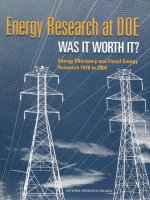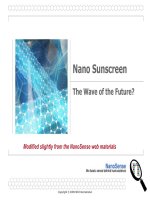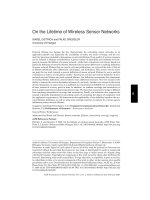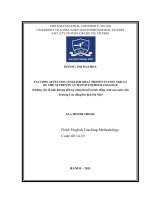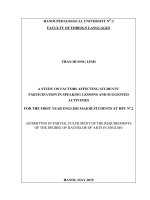The aim of the research is to study the factors affecting the lifetime of pulsed plasma thruster
Bạn đang xem bản rút gọn của tài liệu. Xem và tải ngay bản đầy đủ của tài liệu tại đây (1014.12 KB, 44 trang )
Copyright © 2005 SRI International
Nano Sunscreen
The Wave of the Future?
Modified slightly from the NanoSense web materials
2
Nano Products
•
Number of products using nanomaterials is
growing very rapidly
–
Doubling every year?
•
Clothing, food and beverages, sporting goods,
coatings, cosmetics, personal care
•
Sunscreens: many use nanomaterials
–
Some labeled as containing nanoparticles
–
Some not labeled
3
/>pdf/workshop/rejeski.pdf
4
Why Use Sunscreen?
Too much unprotected sun exposure
leads to:
•
Premature skin aging (e.g. wrinkles)
•
Sunburns
•
Skin cancer
Sources: />5
Skin Cancer Rates are Rising Fast
Skin cancer:
•
Is ~50% of all cancer
cases
•
Has > 1 million cases
diagnosed each year
•
Causes 1 person to die
every hour
Probability of
getting skin cancer:
1930 : 1 in 5,000
2004 : 1 in 65
2050 : 1 in 10…
/>Causes of the increase:
•
Decrease ozone protection
•
Increased time in the sun
•
Increased use of tanning beds
Sources: ;
6
What are sun rays?
•
The sun emits several kinds of electromagnetic
radiation: Visible (Vis), Infrared (IR) and Ultra
Violet (UV)
•
Each kind is distinguished by a characteristic
wavelength, frequency and energy
•
Higher energy radiation can damage our skin
Source: />High Energy Low Energy
7
8
The Full Electromagnetic Spectrum
•
Visible, Infrared and UV radiation are only part of
the full spectrum of electromagnetic radiation
Source: />9
The Sun’s Radiation Spectrum
•
~ 43% is in the visible
range
•
~ 49% is in the near
infrared range
•
~ 7% is in the
ultraviolet range
•
< 1% is x-rays, gamma
waves, and radio waves
.
Most of the sun’s radiation is UV, Vis & IR :
Source: Adapted from />10
What is Radiation?
•
Light radiation is often thought of
as a wave with a wavelength (λ)
and frequency (f) related by this
equation:
Source: />•
Since c (the speed of light) is constant, the wavelength and
frequency are inversely related
•
This means that light with a short wavelength will have a high
frequency and visa versa
11
Two Ways to Think about Radiation Energy
1. Energy Comes in Packets (Photons)
•
The size of an energy packet (E) is determined by
the frequency of the radiation (f)
E ∝ f
E
f
•
Radiation with a higher
frequency has more
energy in each packet
•
The amount of energy in
a packet determines how
it interacts with our skin
12
Two Ways to Think about Radiation Energy
2. Total Energy
•
This relates not only to how much energy is in each
packet but also to the total number of packets arriving
at a given location (such as our skin)
Source: />•
Total Energy depends on many
factors including the intensity of
sunlight
•
The UV Index rates the total intensity
of UV light for many locations in the
US daily: http://
www.epa.gov/sunwise/uvindex.html
13
Skin Damage
•
The kind of skin damage is determined by the
size of the energy packet ( E = h x f)
•
The UV spectrum is broken into three parts:
–
Very High Energy (UVC)
–
High Energy (UVB)
–
Low Energy (UVA)
High Energy Low Energy
Source: />•
As far as we know,
visible and IR
radiation don’t harm
the skin
14
•
Very high energy radiation (UVC) is
currently blocked by the ozone
layer (ozone hole issue)
•
High energy radiation (UVB) does
the most immediate damage
(sunburns)
•
But lower energy radiation (UVA)
can penetrate deeper into the skin,
leading to long term damage
Source: N.A. Shaath. The Chemistry of Sunscreens. In: Lowe NJ, Shaath NA, Pathak MA, editors. Sunscreens, development,
evaluation, and regulatory aspects. New York: Marcel Dekker; 1997. p. 263-283.
Skin Damage II
15
Radiation
Type
Characteristic
Wavelength (λ)
Energy per
Photon
% of
Total Radiation
Reaching Earth
Effects on
Human Skin
Visible
to
Human
Eye?
UVC ~200-290 nm
(Short-wave UV)
High Energy
~0%
(<1% of all UV)
DNA Damage No
UVB ~290-320 nm
(Mid-range UV) Medium Energy
~.35%
(5% of all UV)
Sunburn
DNA Damage
Skin Cancer
No
UVA ~320-400 nm
(Long-wave UV)
Low Energy
~6.5%
(95 % of all UV)
Tanning
Skin Aging
DNA Damage
Skin Cancer
No
Vis ~400-700 nm
Lower Energy
~43 % None
Currently
Known
Yes
IR ~700-120,000 nm
Lowest Energy
~49% Heat Sensation
(high λ IR)
No
Sun Radiation Summary
Increasing
Energy
Increasing
Wavelength
16
With all of this possible damage,
it pays to wear sunscreen, but
which one should you use?
Source: />17
Which Sunscreen Should You Use???
New and Improved
Now with Nano-Z
SPF 50
Goes on Clear
Safe for Children
Broadband Protection
18
The Challenge: 3 Essential Questions
1. What are the most important factors to consider
in choosing a sunscreen?
2. How do you know if a sunscreen has “nano”
ingredients?
3. How do “nano” sunscreen ingredients differ
from other ingredients currently used in
sunscreens?
19
Sources: /> />A Brief History of Sunscreens:
The Beginning
•
First developed for soldiers
in WWII (1940s) to block
“sunburn causing rays”
Shorter wavelengths
(more energy) called UVC
Longer wavelengths
(less energy) called UVA
These were called UVB rays
WWII soldier in the sun
20
Sources: and
/>A Brief History of Sunscreens:
The SPF Rating
•
SPF (Sunscreen Protection
Factor) Number
–
Measures the strength of
UVB protection only
–
Higher SPF # = more
protection from UVB
–
Doesn’t tell you anything
about protection from UVA
•
Sunscreens first developed to prevent sunburn
–
Ingredients were good UVB blockers
21
A Brief History of Sunscreens:
The UVA Problem
•
UVA rays have no
immediate visible effects
but cause serious long
term damage
–
Cancer
–
Skin aging
•
Sunscreen makers working
to find UVA blockers
–
No official rating of UVA
protection yet
Source: />Twenty different skin cancer lesions
22
How do you know if your
sunscreen is a good UVA blocker?
23
Know Your Sunscreen:
Look at the Ingredients
•
Lotion has “inactive
ingredients”
–
Don’t block UV light
•
UV blocking agents are
“active ingredients”
–
Usually have more than
one kind present
Source: Original Image
•
UV blocking agents suspended in a lotion
–
“Colloidal suspension”
•
Two kinds of active ingredients
–
Organic ingredients and inorganic ingredients
24
Organic Ingredients: The Basics
•
Organic = Carbon Atoms
–
Hydrogen, oxygen & nitrogen
atoms are also often involved
•
Structure
–
Covalent bonds
–
Exist as individual molecules
•
Size
–
Molecular formula determines
size
–
Typical a few to several dozen
Å (<10 nm)
Sources: and original image
Octyl methoxycinnamate (C
18
H
26
O
3
)
an organic sunscreen ingredient
25
Organic Ingredients: UV Absorption
1. Electrons capture
the energy from UV
rays
2. They jump to
higher energy
levels
3. The energy is
released as infrared
rays which are
harmless (each ray
is low in energy)
Source: Adapted from />hf=2.48 eV 3hf=2.48 eV
